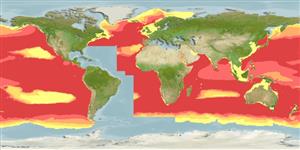Environment: milieu / climate zone / depth range / distribution range
Ekologi
marina batypelagisk; djupintervall 0 - 4500 m (Ref. 4461), usually 1000 - ? m (Ref. 4461). Deep-water
Eastern Atlantic: Bay of Biscay southward to Angola, including the Gulf of Guinea. Indian Ocean: tropical waters. Western Pacific: including the South China Sea. Eastern Pacific: Gulf of California (Ref. 6682) and Chile (Ref. 9068).
Size / Vikt / Age
Maturity: Lm ? range ? - ? cm
Max length : 13.1 cm SL hane/ej könsbestämd; (Ref. 4461)
Life cycle and mating behavior
Könsmognad | Reproduktion | Lek | Ägg | Fecundity | Larver
Quéro, J.-C., T. Matsui, R.H. Rosenblatt and Y.I. Sazonov, 1990. Platytroctidae. p. 265-274. In J.C. Quero, J.C. Hureau, C. Karrer, A. Post and L. Saldanha (eds.) Check-list of the fishes of the eastern tropical Atlantic (CLOFETA). JNICT, Lisbon; SEI, Paris; and UNESCO, Paris. Vol. 1. (Ref. 4461)
IUCN Red List Status (Ref. 130435: Version 2024-2)
Threat to humans
Harmless
Human uses
Verktyg
Special reports
Download XML
Internet-källor
Estimates based on models
Preferred temperature (Ref.
123201): 2.4 - 6.5, mean 3.7 °C (based on 2178 cells).
Phylogenetic diversity index (Ref.
82804): PD
50 = 0.7500 [Uniqueness, from 0.5 = low to 2.0 = high].
Bayesian length-weight: a=0.00407 (0.00154 - 0.01080), b=3.17 (2.94 - 3.40), in cm total length, based on LWR estimates for this (Sub)family-body shape (Ref.
93245).
Trofisk nivå (Ref.
69278): 3.3 ±0.5 se; based on size and trophs of closest relatives
Resiliens (Ref.
120179): Mellan, lägsta populationsfördubblingstid 1,4-4,4 år (Assuming tmax>3).
Fishing Vulnerability (Ref.
59153): Low vulnerability (10 of 100).
